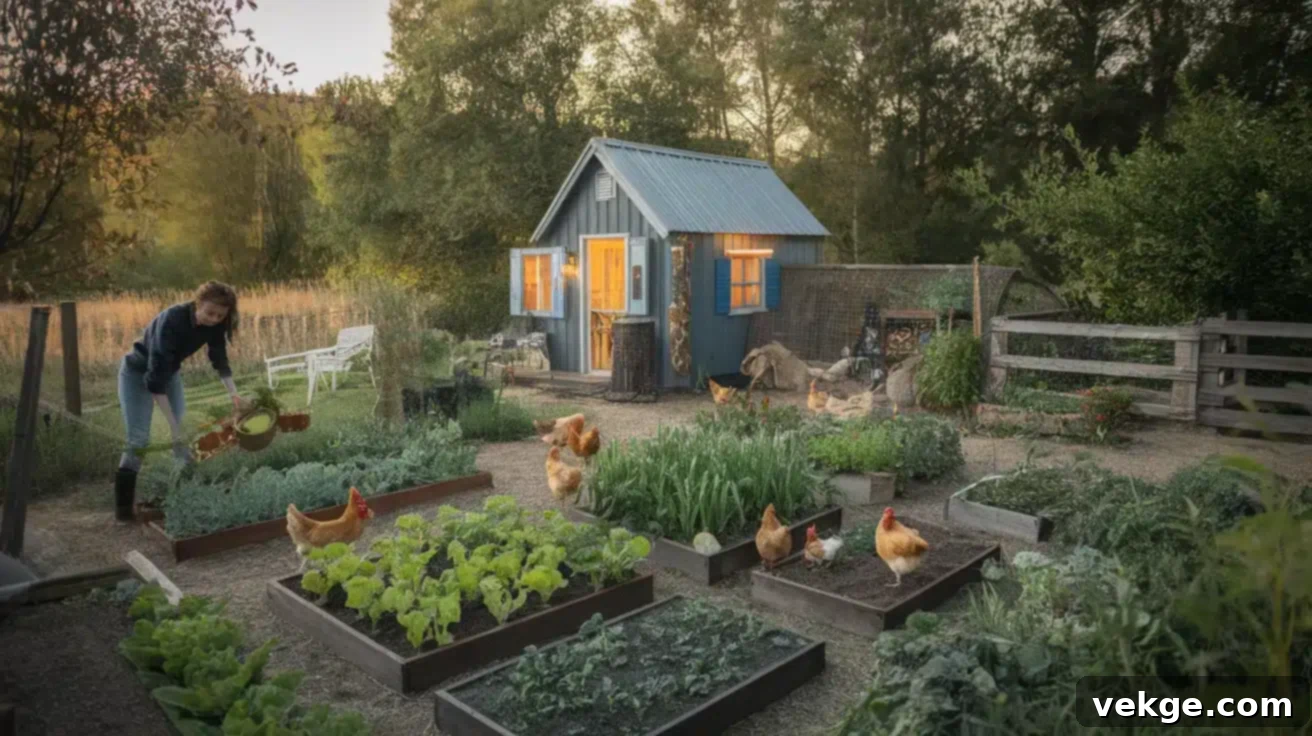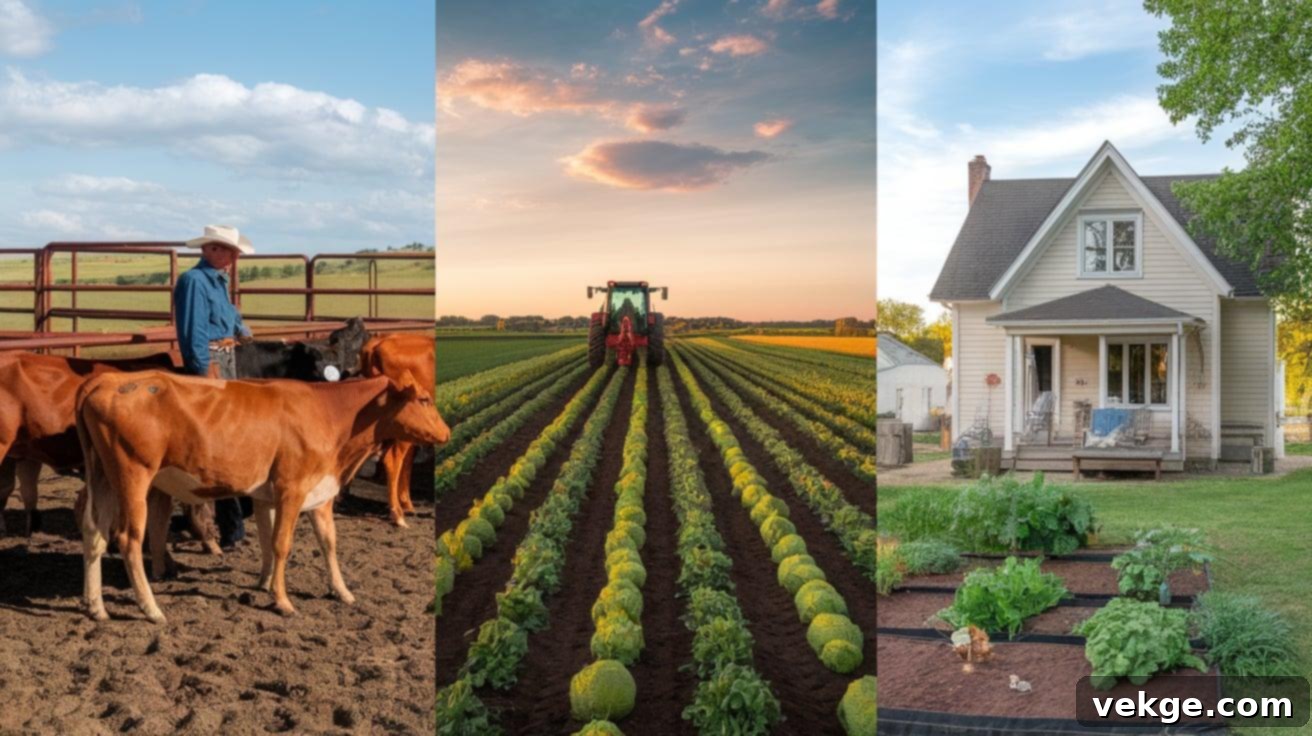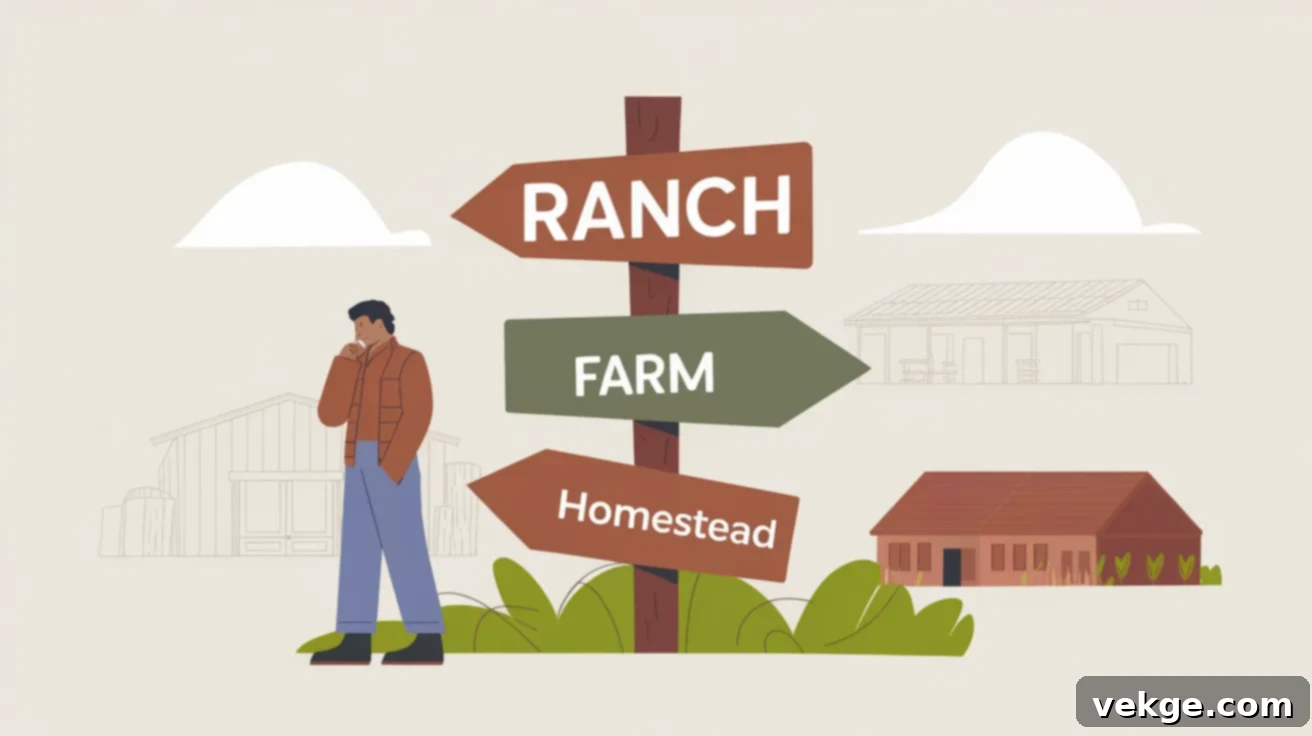Ranch vs. Farm vs. Homestead: The Ultimate Guide to Understanding Rural Land Uses
The allure of country living—vast open spaces, the scent of fresh earth, and the rhythm of nature—is a dream for many. As this dream takes shape, you might find yourself exploring various types of rural properties. Yet, terms like “ranch,” “farm,” and “homestead” are often used interchangeably, leading to confusion. While they all involve managing land, their core purposes, daily operations, and lifestyles can be vastly different.
Understanding these distinctions is crucial, whether you’re planning to invest in land, embark on a food production venture, or simply aim to speak accurately about agricultural and self-sufficient lifestyles. This guide is designed to clarify these concepts, offering a clear roadmap for anyone contemplating a move to the countryside, interested in raising animals, or committed to growing their own food.
Join us as we demystify these key terms, helping you identify which path aligns best with your vision for a life connected to the land.
What is a Ranch?

When you picture a ranch, imagine sprawling landscapes where livestock roams freely and the spirit of the American West feels ever-present. Ranches are more than just land; they are vibrant ecosystems centered around animal agriculture.
Definition & Purpose of a Ranch
At its core, a ranch is a large tract of land primarily dedicated to raising grazing livestock, such as cattle, sheep, or horses. Unlike farms that focus on crops, ranches prioritize animal husbandry for commercial purposes. The primary objective is profit through breeding, raising, and selling these animals for meat, dairy, wool, or equestrian pursuits. Ranchers are essentially livestock producers, managing vast natural resources to support their herds.
Key Characteristics of a Ranch
Ranches are distinguished by their extensive pastures and rangeland, essential for animal grazing. You’ll find fewer cultivated fields and more natural terrain. Daily life on a ranch revolves around monitoring animal health, managing grazing patterns, moving herds, and ensuring adequate water and feed. Ranch owners must also keep a keen eye on market prices for livestock, feed costs, and weather patterns. Transportation across these vast properties often involves horses, ATVs, or trucks, as animals can be spread over hundreds or even thousands of acres. A rancher’s skills often include veterinary care, fence building, and extensive knowledge of land management to sustain the grazing ecosystem.
Types of Ranches
- Cattle Ranches: The most common type, focusing on raising cattle for beef production or, less frequently, dairy. These operations often require vast tracts of land.
- Sheep Ranches: Dedicated to raising sheep primarily for wool, meat (lamb), or milk. They are common in areas with suitable grazing conditions.
- Horse Ranches: Specializing in breeding, training, and boarding horses for various purposes, including racing, riding, or recreational activities.
- Hunting Ranches: Properties managed to attract and sustain wild game, offering guided hunting trips and often combining conservation efforts with commercial recreation.
- Guest Ranches (Dude Ranches): Businesses that provide lodging and recreational activities, such as horseback riding, cattle drives, and other outdoor adventures, allowing visitors to experience the ranching lifestyle.
What is a Farm?

Farms are the foundational pillars of our global food system, embodying a remarkable diversity in their scale and products. From small family plots to massive industrial operations, farms are where our food, fiber, and fuel largely originate.
Definition & Purpose of a Farm
A farm is a parcel of land primarily used for growing crops or raising animals, or often, a combination of both. The central purpose of a farm is production: to cultivate useful resources from the land for commercial sale and consumption. Farms can range dramatically in size and specialization, from growing vegetables for local markets to producing grains for global export, or raising livestock for meat, eggs, and dairy. Their objective is to generate revenue through agricultural output.
Key Characteristics of a Farm
Life on a farm is deeply tied to the growing seasons and market demands. You’ll typically find cultivated fields dedicated to specific crops, alongside barns and outbuildings housing machinery and tools. Farmers rely heavily on agricultural technology, including tractors, irrigation systems, and pest control methods, to maximize yield per acre. Key concerns for farmers include soil health, water management, crop rotation, disease prevention, and securing favorable market prices for their harvest or livestock products. The work is often labor-intensive, requiring a blend of scientific knowledge, practical skills, and business acumen.
Types of Farms
- Crop Farms: Focus exclusively on cultivating plant-based products such as grains (wheat, corn, soy), fruits, vegetables, nuts, or fiber crops (cotton).
- Livestock Farms: Primarily raise animals like cows, pigs, chickens, or goats for meat, sometimes separate from dairy or egg production.
- Dairy Farms: Specialize in milk production from cows, goats, or other animals, often involving milking parlors and processing facilities.
- Poultry Farms: Concentrate on raising chickens, turkeys, ducks, or other fowl for meat, eggs, or sometimes feathers.
- Organic Farms: Adhere to specific regulations that prohibit synthetic pesticides, herbicides, fertilizers, and genetically modified organisms, focusing on sustainable and ecological practices.
- Hydroponic/Aquaponic Farms: Innovative systems that grow crops in nutrient-rich water (hydroponics) or integrate fish farming with plant cultivation (aquaponics), often indoors or in controlled environments.
- Mixed Farms: Operations that integrate both crop cultivation and animal husbandry, often benefiting from the synergistic relationship between the two (e.g., animal waste as fertilizer, crops for feed).
What is a Homestead?

Homesteads embody a philosophy where self-reliance and sustainable living are paramount. These unique properties blend traditional skills with a modern desire for independence, fostering a lifestyle focused on producing for one’s own needs rather than for the marketplace.
Definition & Purpose of a Homestead
A homestead is a piece of land, often with a dwelling, primarily utilized to support the needs of a family or individual, with a strong emphasis on self-sufficiency. The central purpose is not to generate profit, but to produce most of one’s own food, manage resources wisely, and minimize reliance on external systems. Homesteaders often engage in extensive gardening, raising small numbers of livestock for personal consumption (chickens for eggs, goats for milk, a few pigs for meat), preserving food for off-season use, and developing practical skills like carpentry, mending, or basic mechanics. It’s a lifestyle choice centered on sustainable living and personal freedom.
Key Characteristics of a Homestead
On a homestead, the produce from the land typically goes directly to the family’s table rather than to a commercial market. You might find a diverse array of raised garden beds, fruit trees, and small-scale animal enclosures (chicken coops, rabbit hutches, a goat pen). Homesteaders are often adept at various skills, from composting and rainwater harvesting to basic construction and food preservation (canning, dehydrating, fermenting). While some homesteaders might sell surplus produce or crafts, the primary motivation remains meeting personal and family needs. Homesteads can vary greatly in size, from urban or suburban plots utilizing every square foot to multi-acre rural properties. The defining characteristic isn’t size, but the intentional pursuit of independence and a reduced ecological footprint, striving for a long-term, self-sustaining existence.
Key Differences: Ranch, Farm, and Homestead

Now that we’ve explored each type of property individually, let’s lay them out side-by-side to highlight their fundamental differences. This comparison will provide a clear understanding of how ranches, farms, and homesteads diverge in their primary objectives, typical scale, and the day-to-day work involved. These distinctions are vital when considering which path best aligns with your personal goals, financial capacity, and lifestyle aspirations.
While all three involve a connection to the land and often the raising of plants or animals, their core motivations—profit, commercial production, or self-sufficiency—create distinct operational models and ways of life.
|
Feature |
Ranch |
Farm |
Homestead |
|
Primary Purpose |
Raising livestock (e.g., cattle, sheep) for commercial profit. |
Growing crops and/or raising animals for commercial sale and consumption. |
Achieving self-sufficiency and meeting family needs; minimal reliance on external resources. |
|
Typical Size |
Large to very large (often hundreds or thousands of acres), especially for grazing. |
Highly variable (from small market gardens to vast industrial operations). |
Flexible (from urban yards to several rural acres), focused on intensity of use for self-reliance. |
|
Daily Operations |
Herd management, pasture rotation, animal health, fencing, water source maintenance. |
Planting, cultivating, harvesting, irrigation, pest control, livestock care, market preparation. |
Diverse activities: gardening, food preservation, small animal care, DIY repairs, resource management. |
|
Resource Use |
Extensive land, natural grazing, specialized equipment for animal handling (e.g., chutes, trailers). |
Heavy machinery (tractors, combines), specific fertilizers, extensive irrigation, market access infrastructure. |
Limited commercial resources, strong emphasis on reuse, recycling, sustainable practices, and DIY solutions. |
|
Income Source |
Primarily from selling livestock (meat, wool, breeding stock) or related services (e.g., hunting leases). |
Mainly from selling crops and/or livestock products to wholesale, retail, or direct-to-consumer markets. |
Primarily personal consumption; any surplus sales are typically small-scale and secondary to the main goal. |
|
Equipment Needs |
Horses, ATVs, trucks, trailers, corrals, specialized veterinary supplies. |
Tractors, plows, planters, harvesters, irrigation pumps, storage silos, processing equipment. |
Basic hand tools, small garden equipment, food preservation tools, DIY energy/water systems. |
|
Labor Focus |
Animal welfare, feed optimization, market timing, land conservation for grazing. |
Crop yields, soil fertility, weather monitoring, disease management, supply chain logistics. |
Skill acquisition, seasonal planning, resourcefulness, long-term self-sufficiency strategies. |
|
Success Measure |
Profitability of livestock, herd health, and sustainable rangeland management. |
Crop yields, market prices, overall farm profitability, and meeting production quotas. |
Level of self-sufficiency achieved, reduction in external expenses, overall family well-being, and resilience. |
|
Lifestyle Focus |
Rural, physically demanding, often isolated, deeply tied to animal care schedules and seasonal changes. |
Tied to growing seasons, market demands, and technological advancements; can be demanding and business-oriented. |
Values-driven, hands-on, focused on skill-building and independence; often community-oriented around shared goals. |
Summary of Key Differences
- Ranches are expansive properties dedicated to raising large grazing animals for commercial profit, emphasizing livestock management over crop cultivation.
- Farms are diverse agricultural operations that grow crops or raise animals (or both) primarily for commercial sale, playing a direct role in the food supply chain.
- Homesteads prioritize self-sufficiency, using their land to meet a family’s needs for food, energy, and resources, driven by a philosophy of independence rather than profit.
Each type demands different skills, equipment, and levels of investment, reflecting distinct approaches to living and working with the land.
Overlapping Elements and Common Misconceptions
While the definitions above highlight distinct differences, the lines between ranches, farms, and homesteads aren’t always rigidly drawn. Modern agricultural practices and evolving lifestyles can create overlaps, leading to common misunderstandings. Let’s clarify some frequent questions that arise.
Can a Ranch Have Crops?
Absolutely. Many ranches do cultivate crops, but their purpose is usually to support the primary livestock operation. For instance, a ranch might grow hay, alfalfa, or silage crops specifically to feed its cattle during winter months or drought periods. These crops are generally not grown for direct sale as a primary income source, but rather as an integral part of the animal feed program, making the ranch more self-sufficient in its feed production.
Can a Farm Have Livestock?
Yes, indeed. The term “mixed farm” explicitly describes operations that integrate both crop cultivation and animal husbandry. Livestock on a farm can serve multiple purposes: providing meat, dairy, or eggs for sale, contributing manure as natural fertilizer for crops, or even assisting with pest control (e.g., chickens foraging in fields). The integration of animals and crops often creates a more sustainable and diverse farming system, utilizing resources more efficiently and reducing waste.
Is a Homestead Just a Small Farm?
This is a common misconception. While a homestead might be small in acreage, its defining characteristic is its underlying philosophy, not its size. A small farm still operates with the primary goal of producing goods for sale and profit. A homestead, conversely, focuses on producing for personal consumption and self-reliance. While a homesteader might sell a modest surplus, this is secondary to the goal of reducing dependence on external systems. A homestead can thrive on a quarter-acre urban lot just as effectively as on twenty rural acres, as long as its core purpose is self-sufficiency.
Which One is Right for You?

Choosing between a ranch, a farm, or a homestead is a deeply personal decision, one that hinges on your aspirations, practical skills, financial capacity, and the kind of life you envision building. There’s no single “best” option; only the one that aligns most closely with your dreams and circumstances. Let’s explore the factors that can help you determine which path feels right for your future.
Are You a Farmer, Rancher, or Homesteader at Heart?
- Do you dream of wide-open spaces, managing vast herds of animals, and embracing the rugged individualism of the cowboy lifestyle? You might be a rancher at heart. This path demands a deep understanding of animal husbandry and land management.
- Is your passion rooted in cultivating the earth, growing an abundance of food, and contributing to the wider food supply chain? Do you enjoy the challenge of optimizing yields and engaging with markets? Then farming might be your true calling.
- Are you motivated by self-reliance, a desire to live off the grid, and the satisfaction of producing nearly everything you consume with your own hands? Does the idea of mastering diverse skills, from gardening to basic construction, excite you? The homesteading life could be your ideal pursuit.
Key Factors to Consider Before Choosing
- Your Primary Goal: Is your main objective profit generation, contributing to the commercial food system, or achieving maximum self-sufficiency for your family? This foundational question will guide most of your subsequent decisions.
- Time and Lifestyle Commitment: Ranches and commercial farms often demand full-time, intensive labor, tying you to seasonal cycles and animal care schedules. Homesteading can start small and scale up, offering more flexibility in its initial stages, but also requires significant dedication to skill development.
- Financial Investment and Resources: Commercial ranching and farming typically require substantial capital for land, equipment, and initial stock or crops. Homesteading can be more budget-friendly, especially if starting small, but still demands investment in tools, infrastructure, and learning. Explore potential agricultural tax benefits, which can vary significantly by state and property type, for their impact on your bottom line.
- Skills and Willingness to Learn: Each path demands a unique set of skills, from animal health and pasture management for ranchers, to agronomy and market savvy for farmers, and a broad spectrum of DIY and preservation skills for homesteaders. Assess your current abilities and your eagerness to acquire new ones.
- Physical Demands: All three lifestyles are physically demanding. Be honest about your physical capabilities and willingness to engage in strenuous outdoor work in all types of weather.
- Community and Isolation: Consider the level of community interaction you desire. Ranching and farming can sometimes involve significant isolation, while homesteading often fosters strong local communities focused on resource sharing and skill exchange.
- Long-Term Vision: Where do you see yourself in 5, 10, or 20 years? Your long-term vision for sustainability, family involvement, and legacy will greatly influence your choice.
Conclusion
In this comprehensive guide, we’ve explored the distinct characteristics that differentiate ranches, farms, and homesteads. We’ve seen that while they all represent a life connected to the land, their core purposes—commercial livestock production, commercial crop/animal production, or family self-sufficiency—define their unique operational models, scales, and lifestyles.
I hope this detailed breakdown has provided you with a much clearer picture of these three paths. The most suitable choice isn’t about finding a universally “best” option, but rather identifying the one that resonates most deeply with your personal dreams, values, and practical capabilities. Each offers a challenging yet incredibly rewarding way of life, brimming with opportunities to connect with nature and contribute meaningfully.
As you ponder your next steps, consider engaging directly with those already living these lifestyles. Local farmers, ranchers, and homesteaders are invaluable resources, offering real-world insights and advice that no article can fully capture. Their experiences can illuminate the practicalities and joys, helping you fine-tune your vision.
Ultimately, the perfect rural property and lifestyle are the ones that bring you profound joy, meet your specific goals, and allow you to live authentically in harmony with the land.
